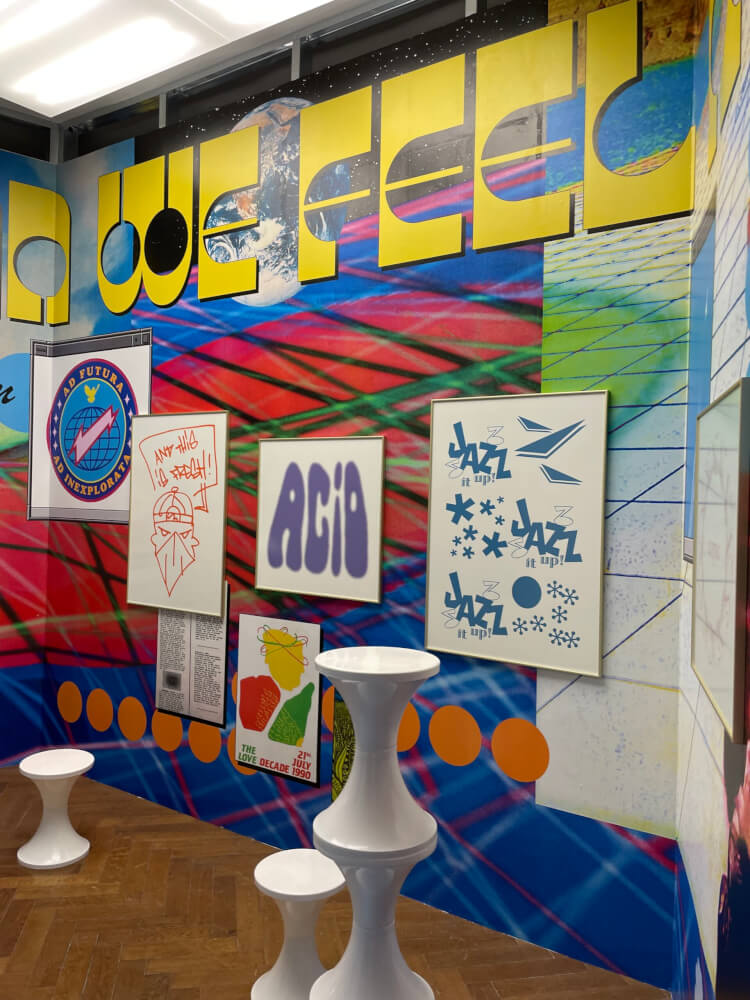
Mark fridvalszki, can we feel it?, 2021, installation. photo: nina vukelic
ISKRA DELTA - a return from the future
We are all aware of the classic sci-fi storyline where a gigantic chunk of metal—an intimidating-looking object— looms over the shifting tinctures of starry skies. It accelerates closer towards the camera signalling the future in which some advanced interplanetary civilisation spills over each pixel of the screen. And future is the ground zero on which the 34th edition of Ljubljana Biennale of Graphic Arts takes its tight choreography. Only the main vehicle isn’t some menacing spaceship but a Slovene computer company Iskra — a now-defunct electronics manufacturer from former Yugoslavia. Continuing to draw from its history, the biennial lends a reverse lens for rethinking technological development — reanimating a bygone potential as Iskra Delta — an entity returning from the future to spread its prophetic tentacles across the exhibition halls.
Bringing together acclaimed international artists and newcomers with a strong focus on the younger generation from the region, Iskra Delta is taking over the three main biennale venues to rethink how we inhabit the present. Blending sensuousness and virtuality, the analogue and the digital, the real and the surreal, the exhibition steps outside the confines of future nostalgia and failed utopias taking a tightrope into the possibilities of other presents seen from the future lens.
KLADNIK & NEON, ISKRA DELTA BOARDROOM. PHOTO: NINA VUKELIĆ
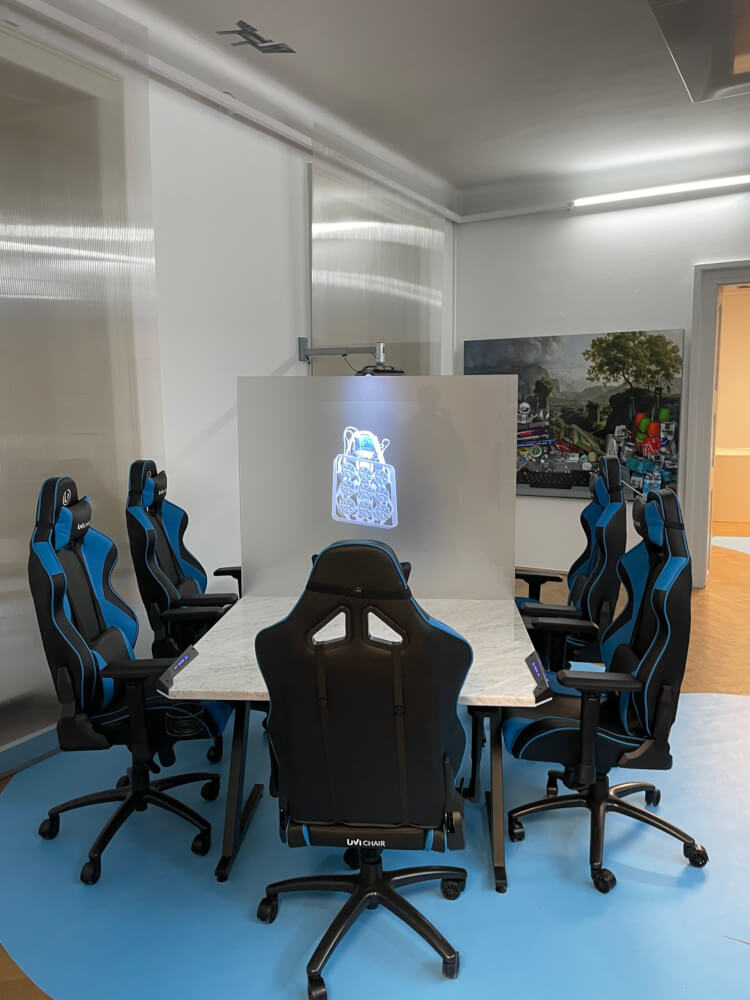
At the central venue MGLC, biennial walks us into a meeting room of Delta Iskra enterprise where the local duo Kladnik & Neon have dreamed up a cyber-looking boardroom complete with plush blue chairs that a gamer turned executive could use. The room feels eerily abandoned and clinical, except for spinning animations flashing from the pseudo-hologram. On show are product developments being designed on the grounds of the Iskra Delta enterprise. Kladnik & Neon’s work moves in and around graphic and industrial design and here the duo has put their CGI aesthetics at work to suggest product prototypes in the making. The eclectic visuals reference both local contexts linked to Slovenian and Yugoslav history and also draw from mainstream tech culture embodied by the Silicone Valley. Coupling polished virtual surfaces and packaging glimmer, the products inhabit a make-believe vacuum of vaporware — spectral prototypes of ideas that are never realised, as if fallen out of today’s technology market in which certain futures are promised but never arrive.
The wave of vapourware mood continues to hover around surrealist scenarios depicted on a series of paintings by Hungarian artist Botond Kerestezi. The post-apocalyptic landscapes (taken from the early Mortal Kombat game) of his Everything is Dying Except Browsing History (2021) paint a mournful take on the consequences of what comes out of the future that never arrives. Kerestezi’s debris left behind the technological advancement is treated in the “natura morta” genre, drawing connections between the speed of technological developments and their deterioration.
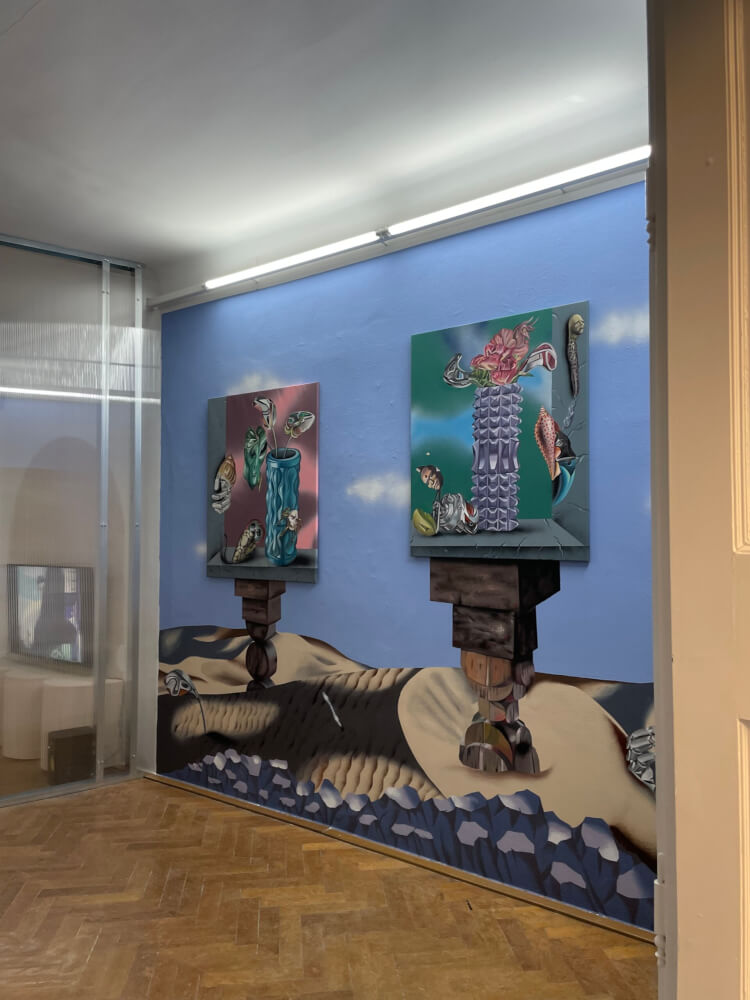
botond keresztesi, everything is dying except browsing history , 2021. PHOTO: NINA VUKELIĆ
The Iskra Delta tentacles tighten with more speculative but no less critical projects. To step inside Suzzane Treister’s TECHNOSHAMANIC SYSTEMS is to enter a compilation of several drawings from her extensive series, featuring both large diagrams and intimate, small-scale drawings. Here gentle watercolour prototypes with their child-like quality clash with technical depictions of different architectural, ecological and fashion models directed at future societies in which interplanetary travel and communication are possible. Transmutations from the spaceship to birds or objects to humans unfold very different sci-fi fictional scenarios priming the imagination for future technology development. Treister’s playful aesthetic exists beyond today’s cold mediation of technology through software or mobile application and here post-human society is examined through ritual, magic and folk traditions. The projects are further detailed in large diagrams that break down the main ideas of technoshamanic systems and the way certain areas of societies would be organised and what would be their purpose.
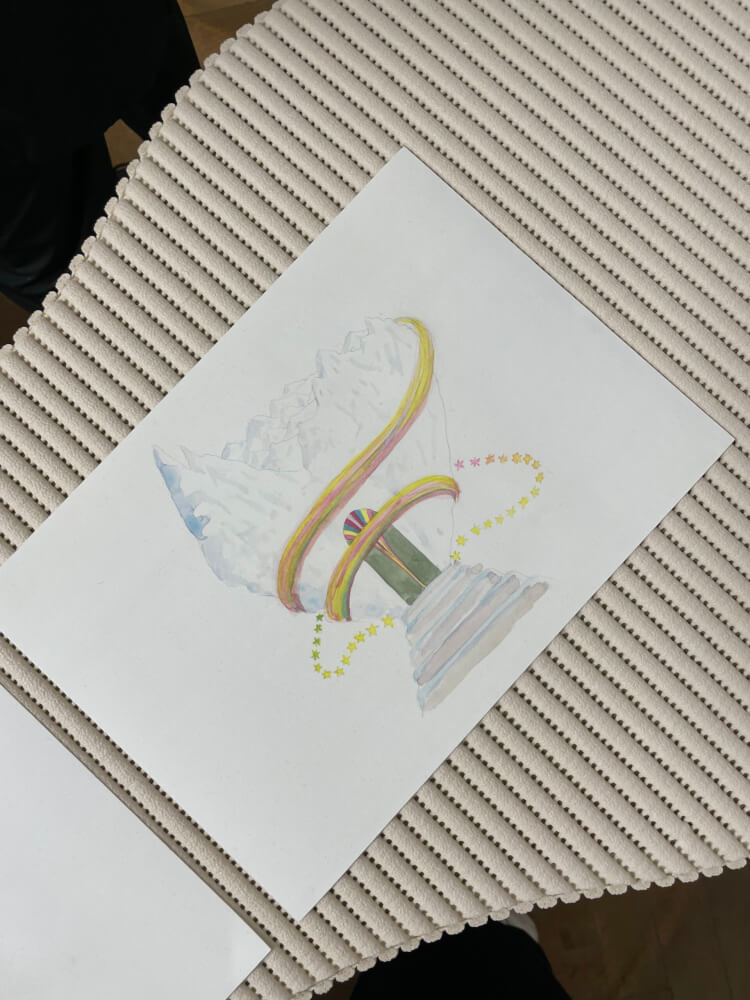
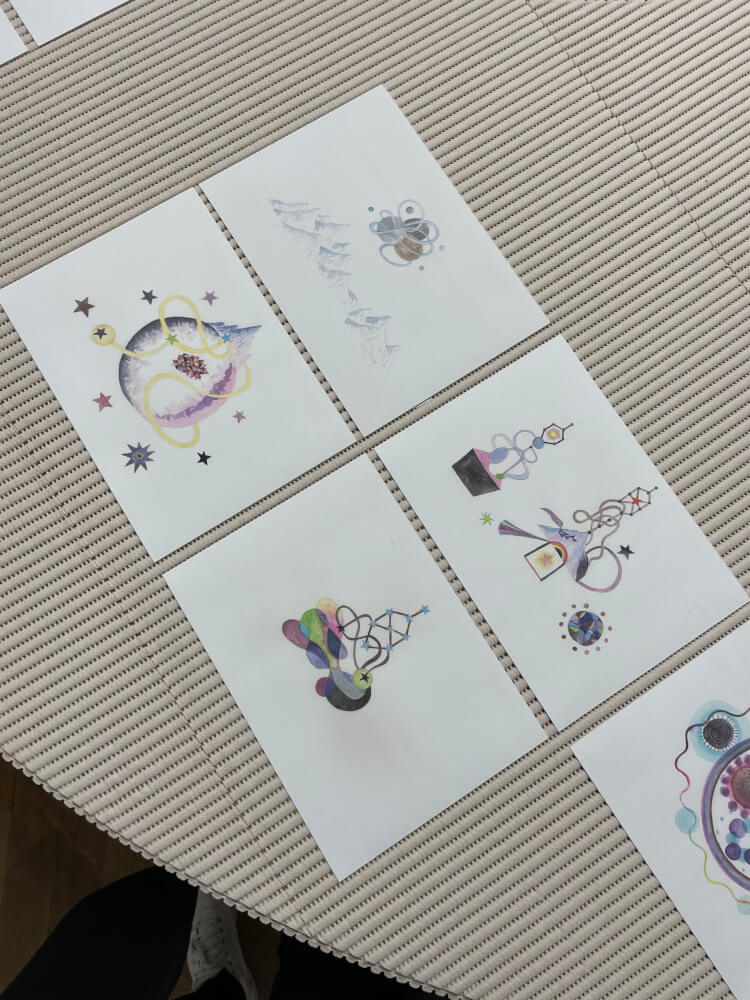
suzanne treister , technoshamanic systems, 2020-21. photo: nina vukelic
In his writings, Mark Fisher has devoted himself to theories of capitalism and Internet culture, characterising the 21st century as an era marked by the loss of our ability to conceptualize a tomorrow that was radically different from our present. Fisher threw a light on the condition where there is no longer a real and significant cultural movement or development — no longer a future. The whole dimension of the future has gradually disappeared, been cancelled, so we find ourselves repeating the past. The innovation, sense of possibility, and continuous production of newness seen in the 20th-century culture of popular modernism no longer exists. “Culture today largely remains in the past”, or as Fisher puts it, is a sentiment that resonates in Mark Fridvalszki’s newly commissioned installation Can we feel it? (2021). A member of the Hungarian futurist collective, he refers to his installation as archeo-futurological meta college where he excavates the historical depths of graphic design and architecture movements that carry a utopian potential. It combines material from two distinct, but in many ways parallel, forward-looking periods: the heyday of "Popular Modernism" in the late 1960s and the period of the Rave Movement's struggle against the neoliberal invasion of the cultural and political imagination in the late 1980s. In reviving the spirit of Mark Fisher Fridvalszki helps us to break through the temporal claustrophobia of our presentist age.
For all its embrace of fiction, speculative design, larping, video games, the Internet, pop and other emerging technologies this year’s edition leaves an open question about the way the digital era rethinks the position of the so-called graphic arts — a medium historically rooted in the foundation of this biennial. Just by thinking about computers as technologies of reproduction, we can draw parallels with shifts in the paradigm that the graphic medium has introduced by disseminating and democratising ideas on a mass scale. Both graphic and digital technologies are bound in their appetite for creating prototypes and models, with computers transmitting the idea of reproduction into our era of machine learning and artificial intelligence into the simulacrum territory.
Text: Nina Vukelic
ISKRA DELTA - a return from the future
We are all aware of the classic sci-fi storyline where a gigantic chunk of metal—an intimidating-looking object— looms over the shifting tinctures of starry skies. It accelerates closer towards the camera signalling the future in which some advanced interplanetary civilisation spills over each pixel of the screen. And future is the ground zero on which the 34th edition of Ljubljana Biennale of Graphic Arts takes its tight choreography. Only the main vehicle isn’t some menacing spaceship but a Slovene computer company Iskra — a now-defunct electronics manufacturer from former Yugoslavia. Continuing to draw from its history, the biennial lends a reverse lens for rethinking technological development — reanimating a bygone potential as Iskra Delta — an entity returning from the future to spread its prophetic tentacles across the exhibition halls.
Bringing together acclaimed international artists and newcomers with a strong focus on the younger generation from the region, Iskra Delta is taking over the three main biennale venues to rethink how we inhabit the present. Blending sensuousness and virtuality, the analogue and the digital, the real and the surreal, the exhibition steps outside the confines of future nostalgia and failed utopias taking a tightrope into the possibilities of other presents seen from the future lens.
At the central venue MGLC, biennial walks us into a meeting room of Delta Iskra enterprise where the local duo Kladnik & Neon have dreamed up a cyber-looking boardroom complete with plush blue chairs that a gamer turned executive could use. The room feels eerily abandoned and clinical, except for spinning animations flashing from the pseudo-hologram. On show are product developments being designed on the grounds of the Iskra Delta enterprise. Kladnik & Neon’s work moves in and around graphic and industrial design and here the duo has put their CGI aesthetics at work to suggest product prototypes in the making. The eclectic visuals reference both local contexts linked to Slovenian and Yugoslav history and also draw from mainstream tech culture embodied by the Silicone Valley. Coupling polished virtual surfaces and packaging glimmer, the products inhabit a make-believe vacuum of vaporware — spectral prototypes of ideas that are never realised, as if fallen out of today’s technology market in which certain futures are promised but never arrive.
The wave of vapourware mood continues to hover around surrealist scenarios depicted on a series of paintings by Hungarian artist Botond Kerestezi. The post-apocalyptic landscapes (taken from the early Mortal Kombat game) of his Everything is Dying Except Browsing History (2021) paint a mournful take on the consequences of what comes out of the future that never arrives. Kerestezi’s debris left behind the technological advancement is treated in the “natura morta” genre, drawing connections between the speed of technological developments and their deterioration.
The Iskra Delta tentacles tighten with more speculative but no less critical projects. To step inside Suzzane Treister’s TECHNOSHAMANIC SYSTEMS is to enter a compilation of several drawings from her extensive series, featuring both large diagrams and intimate, small-scale drawings. Here gentle watercolour prototypes with their child-like quality clash with technical depictions of different architectural, ecological and fashion models directed at future societies in which interplanetary travel and communication are possible. Transmutations from the spaceship to birds or objects to humans unfold very different sci-fi fictional scenarios priming the imagination for future technology development. Treister’s playful aesthetic exists beyond today’s cold mediation of technology through software or mobile application and here post-human society is examined through ritual, magic and folk traditions. The projects are further detailed in large diagrams that break down the main ideas of technoshamanic systems and the way certain areas of societies would be organised and what would be their purpose.
In his writings, Mark Fisher has devoted himself to theories of capitalism and Internet culture, characterising the 21st century as an era marked by the loss of our ability to conceptualize a tomorrow that was radically different from our present. Fisher threw a light on the condition where there is no longer a real and significant cultural movement or development — no longer a future. The whole dimension of the future has gradually disappeared, been cancelled, so we find ourselves repeating the past. The innovation, sense of possibility, and continuous production of newness seen in the 20th-century culture of popular modernism no longer exists. “Culture today largely remains in the past”, or as Fisher puts it, is a sentiment that resonates in Mark Fridvalszki’s newly commissioned installation Can we feel it? (2021). A member of the Hungarian futurist collective, he refers to his installation as archeo-futurological meta college where he excavates the historical depths of graphic design and architecture movements that carry a utopian potential. It combines material from two distinct, but in many ways parallel, forward-looking periods: the heyday of "Popular Modernism" in the late 1960s and the period of the Rave Movement's struggle against the neoliberal invasion of the cultural and political imagination in the late 1980s. In reviving the spirit of Mark Fisher Fridvalszki helps us to break through the temporal claustrophobia of our presentist age.
For all its embrace of fiction, speculative design, larping, video games, the Internet, pop and other emerging technologies this year’s edition leaves an open question about the way the digital era rethinks the position of the so-called graphic arts — a medium historically rooted in the foundation of this biennial. Just by thinking about computers as technologies of reproduction, we can draw parallels with shifts in the paradigm that the graphic medium has introduced by disseminating and democratising ideas on a mass scale. Both graphic and digital technologies are bound in their appetite for creating prototypes and models, with computers transmitting the idea of reproduction into our era of machine learning and artificial intelligence into the simulacrum territory.

